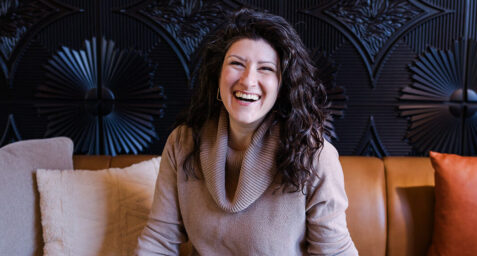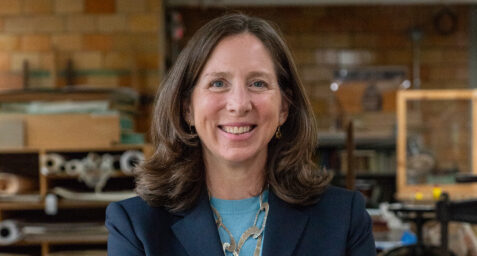Jaime Goodhue JM ’20: Honing Jewelry and Themselves
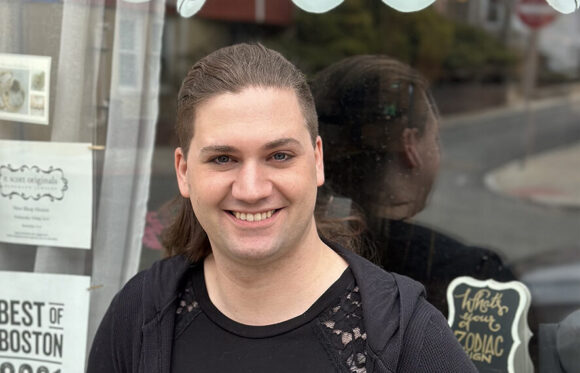
Get to know recent Jewelry Making & Repair graduate Jaime Goodhue JM ’20, who works with fellow NBSS alum Emily Scott Surette JM ’07 her shop, at e. scott originals, in Somerville, Massachusetts.
Jaime explored many aspects of art-making before training at NBSS. Their transformation along the way was a deeply personal one: “I worked out so many more things than just learning how to make jewelry at North Bennet. It changed my life for the better, and I’m so grateful for it.”
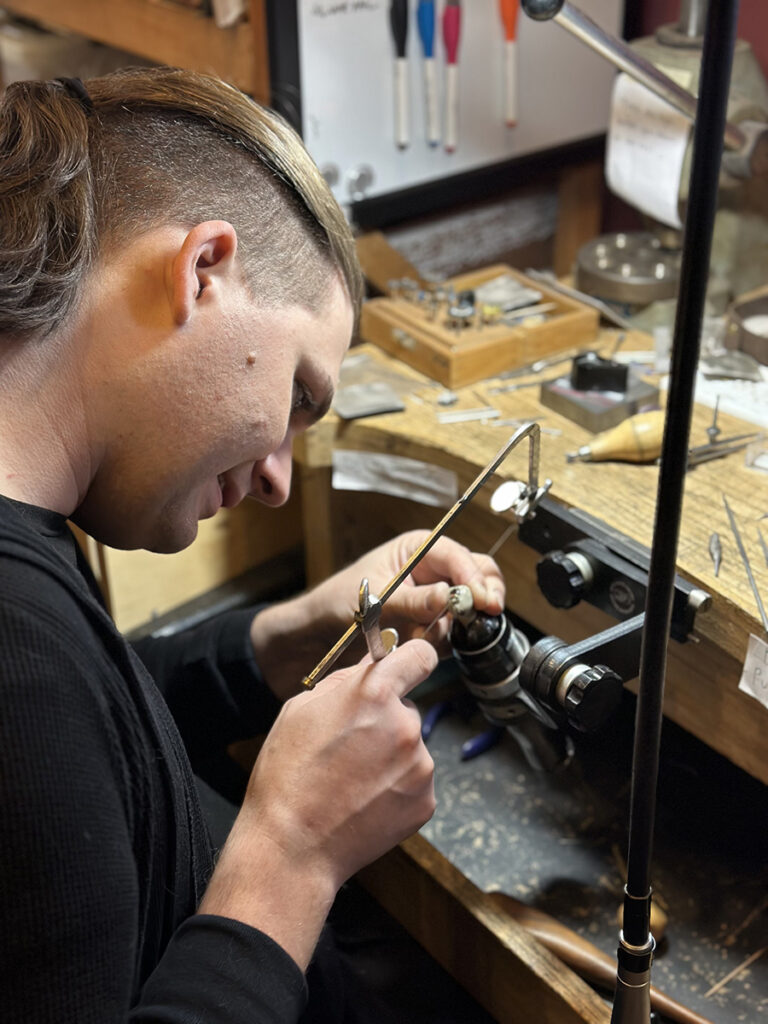
I graduated from NBSS in 2019/2020 (a few extra months due to the pandemic). Shortly after graduating, I saw a posting on the School’s job board for e. scott originals and that led me to meeting Emily. I’ve been working with her just over two years now, and it feels like my career dreams have come true. This job is pretty close to what I imagined as my end goal coming to North Bennet Street: I wanted to find somewhere where I wasn’t just another worker, and I like being in a small shop where you feel like a real part of it. Emily understands and shares her process and vision for her business. We’ve formed a teamwork together, and she always makes me feel appreciated.
One of the biggest perks of both being NBSS grads is we have the same vocabulary. When we communicate what needs to get done and how, there’s an underlying understanding of techniques and processes. It helps us get on the same page faster. Also having a similar background means we have a similar sense of aesthetics, and we can play off each other.
Emily has been a great mentor, and has helped me launch my own brand as well, Featherwind Forge. She’s been guiding me through best things to do, things not to do. Especially when you’re just one person starting out, there’s a balance between taking on custom projects and building up your brand, when custom jobs can be few and far between when you’re starting out. Finding my niche has been a process.
Before North Bennet, I went to art school and I was initially trying to start a career in sculpture. So I had been through this process a little bit before. But every time you move into a new medium, there’s a discovery process of, “What do I actually want to make?” Because the world is so open and there’s so many options, you have to narrow it down.
What led you to become a student at NBSS?
For me, I always wanted to work in an artistic capacity. I started off doing sculpture out of high school. I was dealing with issues of anxiety and depression in high school, so I was always trying to find a way to break out of that, but none of the typical extracurricular activities interested me. My first foray into sculpture was at the Putney School in Vermont, in a summer program which included one jewelry class there. I had no idea that jewelry making would be my future, it was just a fill-in class among creative writing and stone sculpture. I leaned into larger-scale sculpture after that, and took welding and bladesmithing classes through the Continuing Education program at MassArt. And that’s really where I fell in love with working with metal, and started taking steelworking very seriously.
Later, I was doing a student internship in the Education department at the Higgins Armory Museum in Worcester (which is sadly now closed), which took me into the history of steel working and its ancient background. Interestingly, the things I loved the most about their collections were the details in the gold and silver, the inlays. I also interned with a blacksmith in Worcester, and there I realized that if you want to be a steelworker or a blacksmith these days, about 98% of what you’re going to do is fences and gates. And I wasn’t really interested in that enough to make it my living.
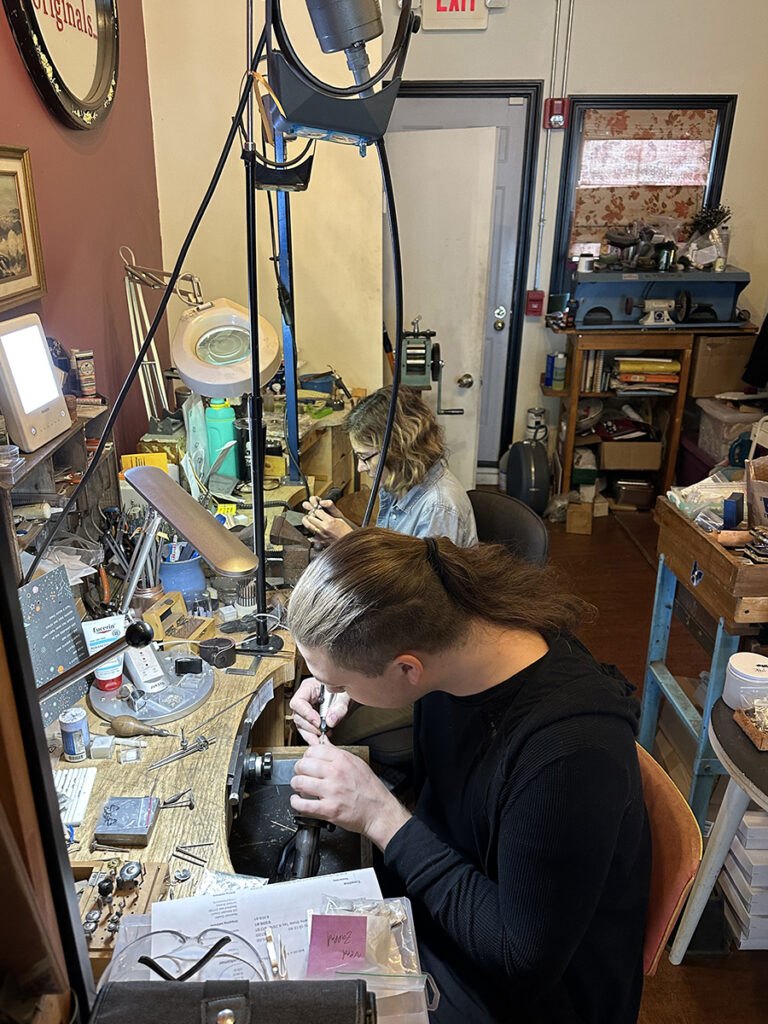
I was struggling to figure out how to make a living through my art, which led me to retail and food service jobs in San Francisco and Boston. But eventually, I reached a point where I felt I couldn’t keep jumping around jobs forever, but I still really wanted to make things with my hands. So I tried some online YouTube classes in jewelry making. Then I reached a point where I wanted to set stones, and it became clear I needed more in-person instruction. So I found North Bennet Street School and thought, this program could change my life in just a couple of years.
I started in 2018, and then the pandemic happened, so it took me a little longer than some others to get through the program. I was also working through some personal skills beyond just jewelry making, like my time management. That was a big one for me—figuring out how to actually do things on a time frame. And through most of my school experiences I didn’t have anyone able to creatively teach me how to do that for myself quite the way that our Instructor Ann Cahoon JM ’02 did it. When you’re dealing with such a physical process, you can break it down into concrete things. Making yourself a list of things you need to get done, checking them off as you go, setting goals. That was really transformative for me, not just at work, but in my personal life.
I worked out so many more things than just learning how to make jewelry at North Bennet. It changed my life for the better, and I’m so grateful for it.
What’s your role at e. scott originals, and what does a typical day look like?
I come in in the morning, have a cup of coffee, and get the shop all set up. We put everything away at night, so I put everything back out, and get the cases looking nice. And then we open up the curtains and we’re open!
Every day is always different here, which is a lot of fun. We’ve always got something different going on in the back. I’m the inventory manager, so I make the the pieces we sell in the shop cases—necklaces, rings, earrings—but there’s always something different about the process.
One thing I’ve struggled with as someone with ADHD, is any time I get into a place where I need to be doing the same thing over and over and over again, it’s hard to keep with it. But because I have so many projects going here all the time, there’s always something different that might come up. It will either be something new, or it’s different from the last time I did it.
So after opening up the shop, I take the day as it comes. We often have people walking in, coming to see us for the first time. We have a lot of word of mouth referrals. They might fall in love with something in the case, or they’ve got a fun new custom project for us, whether it’s an engagement ring, wedding ring, or something entirely different. We’ve done a lot of revamps of old jewelry as well.
I enjoy guiding people through the initial parts of the custom projects, and helping them find something they might be wearing for the rest of their life.
Where do you get your inspiration?
Walking out in the woods or going to the Arboretum in Jamaica Plain is my main inspiration. I love all the forms that nature provides us with: thinking of earth as the ultimate artist. No matter what we make, all the materials we’re using come from the same place.
I do a lot of live castings from nature, so I think of it as replicating nature with nature. I’ve always loved nature and found it really healing, so I wanted to capture that in jewelry form. My pieces are very different from what we learned at NBSS, where we made cleaner and more modern forms. Working with nature castings has its own set of challenges, which I enjoy. Sometimes you can’t do too much with them: you can’t polish them too hard, you can’t do much grinding, you have to work with what you’ve got.
I also read a lot of sci-fi and fantasy books and watch a lot of Lord of the Rings, picking out the cool rings the elves are wearing.
Could you describe your work in 3 words?
Hippie witch cottage-core, or nerdy, nature-based, and high fantasy
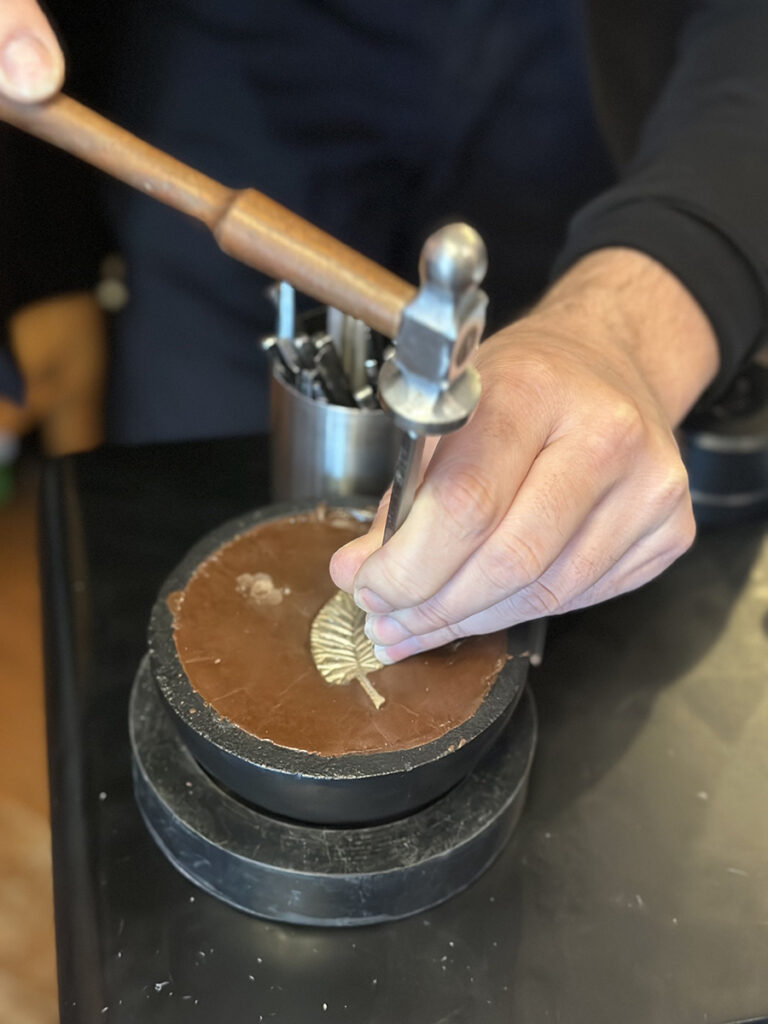
Favorite tool or machine?
Our GRS holder is my most-used tool and the thing I’m most grateful for right now, because it makes everything easier.
But lately I’ve also been getting into chasing and repoussé. So my pitch pot has become a big one too.
Dream project or job?
I’ve always wanted to make a crown.
What do you love about jewelry making?
Some of my favorite parts of working with metal are more the philosophical aspects, which you can apply to other parts of your life. Metal is in this constant state of flux: you can always bend metal, it can always be put back the way it was, you can always change it.
And in jewelry, nothing is ever really broken; you can always fix it. No matter how damaged something might look, there’s always a way to go in and add more metal, or cut something out, maybe simplify something—there’s always a way to make it a little better. I like taking that attitude from North Bennet, where instead of giving up on a project, we say, “no, we can do something to fix it,” and everything looks great in the end.
Best advice you’ve gotten?
One of the things I’ve always had trouble with (in all areas of my life) is I tend to make everything way more complicated than it needs to be. So one thing Emily is always reminding me of is keep it simple, and achievable. There’s a lot you can do even when keeping it simple. And sometimes that’s even the better option, rather than spending seven, eight hours on a single piece, because that time ends up costing your customer more, which is not what I want. I want customers to have beautiful things, but I don’t want them to end up costing $1,000, I want anybody to be able to wear what I’m making.
What personal or professional advice do you have for students working in the jewelry industry?
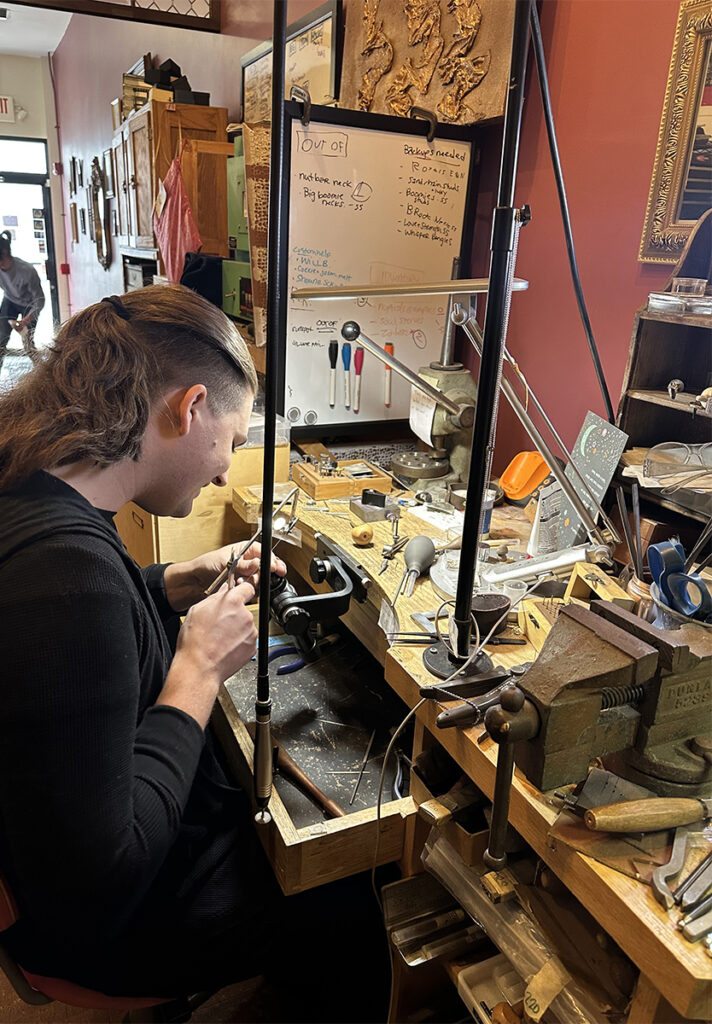
For current students: stick with the program, because it’s really worth it, and you’ll get a lot out of it. We all have those moments where we feel like quitting, but those are also the most important times to take a step back and recommit. A few years down the line, you’ll look back and you’ll smile and say, “I did that.”
One of the most frequent comments I get, from people of all walks of life, is “Oh, I could never do that or make that.” I don’t think people give themselves enough credit, because if anyone puts the work in, they could do this. If you really dedicate yourself to something, you can get there.
Something my father always tells me is to start at the end. If you’re thinking about applying to NBSS, or if you’re in any of the programs currently, it’s important to keep that end dream or vision in sight, because that’s what’s going to drive you forward.
For graduating students: the job market, at least in Boston, has been really hard right now. And it can be really overwhelming, because in the jewelry industry, there are so many niches. Finding what you want to do can be tricky. Don’t be afraid to try something out, and if it’s not working out, it’s never too late to change.
And if you’re thinking about starting your own business, I’d recommend giving it a try. Because it may seem daunting and really big, but if you take your time and work out all the details, it’s worth it. It doesn’t take as much as you might think.
